You are here
A Pragmatic Bet: The Evolution of Spain’s Immigration System

Farmworkers in Murcia, Spain. (Photo: iStock.com/Worledit)
Historically a country of emigration, primarily to the Americas and Northern Europe, Spain has in recent decades become a major immigrant destination, with the foreign born comprising a larger share of the population than in the United Kingdom, the United States, or other major destination countries. There is a common misperception that a defining feature of Spain’s current immigration regime is large numbers of people in irregular status. This idea is given new life by media coverage of migrants crossing the Strait of Gibraltar, around the Canary Islands, or climbing fences in the North African enclave cities Ceuta and Melilla. While irregular status was indeed endemic in the 1980s and 1990s, as a result of a glaring mismatch between strong demand for foreign-born workers and overly restrictive regulations, Spain’s immigration management has matured considerably since then. Gone are the times when legal immigration was all but impossible and when large shares of immigrants in Spain lacked authorization for living there.
Spain’s immigration policies are now remarkably inclusive, not only by historical standards but also compared to peer nations. Although these policies do not guarantee immigrants will quickly acquire natives’ living standards, Spain provides the vast majority of its 7.5 million foreign-born residents access to extensive civic and social rights, including a path to citizenship. These policies, which are better attuned to the country’s labor market demands and the aspirations of immigrants, have largely escaped political backlash, due in part to regulations allowing unauthorized immigrants the opportunity to secure legal residence so long as they prove an employment history or social integration. This approach was forged in the early 2000s amidst a rapid increase in Spain’s foreign-born population and survived a subsequent economic crisis during which the unemployment rate hit 27 percent. Yet it remains a potentially risky bet by the government, as demonstrated by the recent successes of the radical-right VOX party, which has embraced nativist rhetoric.
This article examines Spain’s demographics, immigration policies, and attitudes towards immigrants, focusing on the decades since the death of dictator Francisco Franco in 1975 and particularly since Spain’s financial and labor market crisis from 2008 to 2014. Despite becoming a major immigration country much later than other Western nations, Spain’s demographic transformation has become irreversible. In recent years this evolution has been accompanied by a distinctive policy allowing stepwise administrative stabilization that prevents irregular status from becoming a self-perpetuating trap.
From Laggard to Leader
Accounting for nearly 16 percent of its population, Spain has one of Europe’s highest shares of foreign-born residents. Far exceeding the EU average (12 percent) and the proportion of immigrants living in other Southern European countries such as Italy (10 percent), Spain’s share is in the ballpark of those of Germany (18 percent) or the Netherlands (14 percent), which have received sizable immigration flows for much longer periods of time.
This situation represents a remarkable turnaround for a country long known for its emigration history. From the mid-19th century until the mid-20th century, about 2.5 million people left Spain for former colonies in Latin America and, to a lesser degree, North Africa, particularly after the creation of the Spanish protectorate in Morocco in 1912. Another 500,000 refugees fled during the Spanish Civil War (1936-39), and between 1950 and 1970 about 2 million Spanish workers moved to other European countries such as Germany or Switzerland. All told, almost 5 million Spaniards emigrated during this era.
This pattern started to change with the economic crisis of the 1970s. Spain had already been receiving some returning emigrants and others, such as European retirees, African workers (mostly from Morocco), and Latin Americans seeking refuge from military dictatorships. However, these inflows were rather small. After the end of Franco’s rule, Spain began to attract increasing numbers of foreigners aiming to fill occupations that had become unappealing to natives. Yet immigration remained fairly low during the 1980s and only in the second half of the 1990s did Spain begin to turn into a high-intensity immigration country, a trend that escalated at the beginning of the 21st century amidst a strong economic boom. The share of foreign-born residents rose from 3 percent in 1998 to 13 percent a decade later, while the immigrant population surged from about 1.2 million to 6 million, a fivefold increase (see Figure 1).
Figure 1. Foreign-Born Residents of Spain, by Nationality, 1998-2022
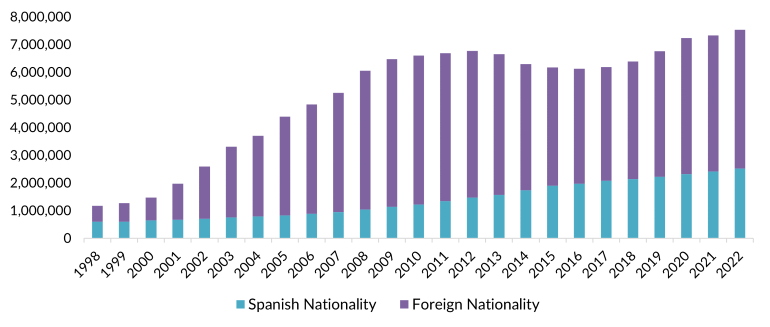
Note: “Spanish nationality” refers primarily to immigrants who became naturalized Spanish citizens after residing in Spain for a period of time, but also includes other circumstances, such as people born abroad who acquired citizenship through Spanish parents or ancestors.
Source: Spanish National Statistics Institute (INE), “Population (Spaniards/Foreigners) by Country of Birth, Sex and Year,” accessed March 17, 2023, available online.
This immigration rate is extraordinary by any standard; having converted into an immigration country later than its peers, Spain caught up quickly. Boom then turned to bust. In 2008, the construction industry collapsed, pushing the labor market into a tailspin. Within five years, one out of every five jobs in Spain was lost. Immigrant workers were affected even worse than natives. Yet considering this context, the size of the foreign-born population remained remarkably stable, never dipping below 6 million. Official statistics undercount emigration, which intensified during the crisis, and immigration flows dwindled. The government also launched a new program in 2008 offering unemployment payments to thousands of out-of-work immigrants who returned to their origin country. However, only about 10,000 migrants benefited from these kinds of organized return schemes; the massive exodus predicted by many pundits did not materialize. In recent years (except for a temporary setback caused by the COVID-19 pandemic), net inflows have again accelerated to about 500,000 immigrants per year.
Current Demographics
Spain’s overall population experienced an astonishing 19 percent growth between 1998 and 2022, rising from 40 million to 47.5 million, due almost entirely to international immigration. In this context, the composition of the immigrant population has changed significantly. While the proportion of people from Africa remained rather stable, the shares of Latin Americans and Asians have nearly doubled, whereas Europeans now account for a much smaller share than 25 years ago. Presently, about 43 percent of Spain’s foreign-born residents come from Central or South America, 30 percent from other European countries (mostly those in the European Union), 18 percent from (mostly North) Africa, and 7 percent from Asia (see Figure 2).
Figure 2. Foreign-Born Population of Spain by Region of Birth, 1998 and 2022
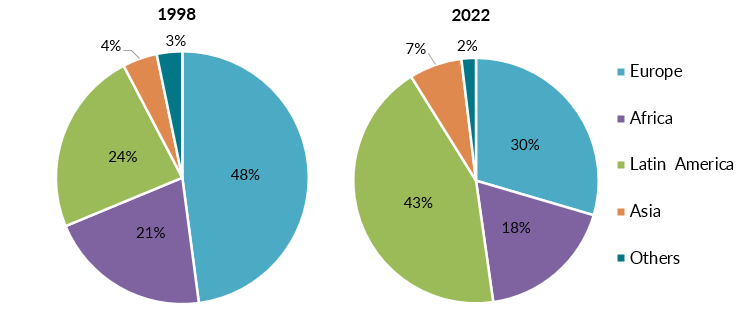
Source: INE, “Population (Spaniards/Foreigners) by Country of Birth, Sex and Year.”
In line with this general pattern, South American nations now feature much more prominently among immigrants’ countries of birth. The single largest origin in 2022 was Morocco (accounting for 13 percent of immigrants), followed by Colombia (8 percent), Romania (7 percent), Venezuela and Ecuador (6 percent each), and Argentina (4 percent). Aside from Morocco, which has recovered the top spot it temporarily ceded to Romania, all these countries have leapfrogged the United Kingdom, which rated second among all places of origin in 1998. Meanwhile, Spain’s nearly 200,000 Chinese immigrants in 2022 outnumbered those from all EU Member States except for Romania and France. Most immigrants arrive for family reunification and employment-related reasons, but there is also a sizable volume of lifestyle migrants (mainly retirees from Northern Europe) and, in recent years, a growing number of asylum seekers.
The size of Spain’s emigrant population, meanwhile, has remained mostly steady for the last three decades. The 1.5 million Spanish-nationality emigrants as of mid-2020—a good deal of them Latin Americans who had obtained Spanish citizenship—were only slightly more than the 1.4 million in 1990, according to UN data. Two-thirds lived elsewhere in Europe, 23 percent in Latin America and the Caribbean, and 8 percent in North America. Neighboring France was the top destination (home to 19 percent of emigrant Spaniards), followed by Germany (12 percent), the United Kingdom (10 percent), and the United States and Argentina (7 percent each).
Maturing Policies: The Labor Market and Border Management
For two decades, from the first specific piece of legislation on international migration (1985) until the last of six mass regularizations (2005), irregular immigration represented a structural feature of Spain’s migration regime. Rather than tackling the root cause of this phenomenon—a mismatch between the economy’s need for foreign workers and a lack of adequate recruitment channels—the government initially focused on impeding the most visible unauthorized border crossings. A sophisticated system of maritime border surveillance, the Sistema Integrado de Vigilancia Exterior (SIVE), was created in the Strait of Gibraltar (later extended to the Canaries) and increasingly impenetrable fences were erected around Ceuta and Melilla, the enclave cities surrounded by Morocco. Arguably, these measures were more effective in fostering Spain’s credentials as a model for Southern Europe’s border management than actually controlling irregular migrants, a majority of whom entered through authorized channels, such as with a tourist visa, and later fell into irregular status. A growing number of foreigners living and working in Spain lacked administrative authorization to do so.
To address this situation, between 1986 and 2005 Spain carried out six mass-regularization processes, which gave legal status to about 1.2 million immigrants (see Table 1). In contrast to countries such as the United States, where regularization is a subject of heated political debate, Spanish institutions and stakeholders (including the major trade unions) were in agreement that an increasing immigrant population with irregular status was more problematic, in part because those constrained to work in the informal economy would not pay income taxes or contribute to social security programs.
Table 1. Outcomes of Large-Scale Regularization Processes in Spain, 1985-2005
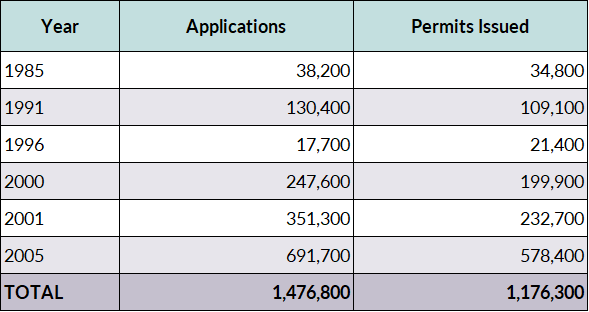
Source: Joaquín Arango and Claudia Finotelli, “Past and Future Challenges of a Southern European Migration Regime: The Spanish Case,” (IDEA working paper No. 8, N.p., May 2009), available online.
Still, these policies were not without controversy. While temporarily patching the most obvious economic challenges, these legalization campaigns were vocally criticized by Northern European leaders, who feared the now-regularized migrants would move freely to other EU Member States. This criticism flared each time Spain repeated these regularization measures, each of which was advertised as the last.
Against this backdrop, Madrid abandoned headline-grabbing regularizations by establishing provisions that allow for individuals to secure legal status after three years of irregular residence if they can prove some kind of roots (arraigo), such as a certain level of social integration (arraigo social) or protracted employment (arraigo laboral). Individual arraigo programs were implemented by Royal Decree 2393/2004, which spells out the fine print of Organic Law 4/2000, perhaps the most fundamental pillar of Spain’s migration regime. This law granted immigrants extensive civic and social rights by virtue of having registered at any of the country’s approximately 8,000 municipalities (Padrón municipal). Unlike other countries, such registration does not necessarily require a residence permit; an identity document and utility bill stating name and address might suffice, meaning that unauthorized immigrants can often register with little difficulty.
This remarkably inclusive approach was partly value-driven and partly pragmatic. After the formal demise of the reclusive Franco regime and the approval of a new constitution in 1978, Spanish society strived for expansive civic and social rights in general, and openness toward people and lifestyles from abroad in particular. In the post-Franco political culture, Spain’s leaders fueled a widely cherished collective self-image by granting immigrants unrestricted access to public services such as education and health care. More tangibly, policymakers also realized that understaffed and multilayered bureaucracies were incapable of matching the market’s speed and efficiency at adjusting labor supply to demand. From this viewpoint, the key challenge was not to impede foreign workers’ arrival but to improve the likelihood that they could access formal employment.
Hence, the Padrón approach to migration governance might be interpreted as a bet that, over time, a vast majority of initially irregular migrants would turn into taxpayers—and, critics would add, an abundant supply of foreign workers would contribute to keeping wages down. In fact, Spain’s Padrón-based immigration model relies on a much broader consensus than divisive political rhetoric suggests. Center-left governments (in power from 2004 to 2011 and again since 2018) have strived for more visible integration policies, yet the model’s foundational provisions were launched during and maintained by center-right administrations (in power from 1996 to 2004 and from 2011 to 2018). A reduction of immigrants’ health-care rights in 2012 was later rescinded.
The reorientation of Spain’s immigration regime included improving labor recruitment channels beyond and within the country. Until 2004, employers had to prove that there were no workers available in Spain for the job on offer (certificación negativa) before hiring any third-country nationals from abroad. Decree 2393/2004 made the recruitment system much more flexible by creating a catalogue of occupations with labor shortages, which is updated every three months and allows employers to avoid burdensome paperwork. Due to the economic downturn, in 2008 the list was reduced to just a handful of occupations, while pending reforms of the labor recruitment system were put on hold.
More recently, amid the economic recovery following the ebbing of the COVID-19 pandemic (and despite geopolitical uncertainty triggered by the war in Ukraine), the new Decree 629/2022 uses various measures to improve immigrants' employment prospects. Access to the labor market has become easier for foreign students, the procedure for certifying that occupations are affected by chronic labor shortages has been streamlined, temporary work-related residence permits have been extended from two years to four, renewals are more flexible, and a new form of arraigo facilitates residence permits for immigrants attending courses organized by the Public Employment Service. These improvements confirm the government’s willingness to strengthen employment as a centerpiece of Spain’s immigration regime.
As such, thanks to the development of an increasingly predictable path toward administrative regularity and stability, the lack of legal immigration status does not necessarily convert itself into a self-perpetuating trap, as is the case in the United States, for example. Rather than focusing on the distinction between temporary and permanent immigration, Spain’s model is predicated on stabilization step by step.
The ability to gain legal status based on labor market integration is also available to humanitarian migrants. Asylum applications in Spain have increased considerably since 2014 (Figure 3). Most asylum seekers are from Venezuela, yet less than 1 percent of their applications are recognized. Because of the strained diplomatic relations between the two countries, it has been impossible to return these unsuccessful applicants to Venezuela. Instead, in 2019 the Spanish government declared that Venezuelan asylum seekers whose cases were rejected in 2014 or later are eligible for humanitarian residence permits which last for one year, with a possibility of a one-year extension. Venezuelans with this status have access to the labor market and therefore can eventually obtain a residence permit for work purposes. The option for unsuccessful asylum seekers to become labor migrants is emblematic of the pragmatism that has defined Spain’s immigration regime since the turn of the century.
Figure 3. Asylum Applications Submitted in Spain, by Applicants’ Country of Origin, 2014-22

Source: Spanish Interior Ministry, Asylum and Refugee Office, “Datos e información estadística,” accessed March 17, 2023, available online.
Public concern about immigration surges when people perceive border control to fail (as was the case, most notably, during the “cayuco crisis” of 2006), so border management needs to be seen as effective for these kinds of policies to be politically viable. Spain is no exception in this regard. In 2022, the government applauded Morocco for its handling of an attempted storming of the fence at Melilla, a small city on the African continent across the Alboran Sea from mainland Spain. The incident left 18 people dead, prompting outcry from humanitarian organizations, which both governments shrugged off with startling nonchalance. Meanwhile, Spain’s pushbacks of unauthorized migrants towards Morocco, which prevent individuals from being able to seek asylum, have been a longstanding cause of humanitarian concern but were endorsed by the European Court for Human Rights in 2020 on the grounds that “the lack of an individualized removal procedure had been a consequence of the applicants’ own conduct.”
Spain’s external controls do not consist only of fences and pushbacks, but also cooperation frameworks with transit and sending countries. Between 2004 and 2008, Spain signed several bilateral agreements to reward countries (Mali, Nigeria, and Gambia, among others) that actively cooperate against irregular migration. These “new generation agreements,” which were mainly signed with African countries, are not a Spanish invention; Italy had previously pursued similar strategies with Tunisia and Egypt, for example. However, unlike with Italy, their conditionality clauses are not restricted to labor migration quotas but also development aid and trade agreements.
Legal Status: A Stabilizing Force in Times of Economic Upheaval
Since citizens of Member States are entitled to live anywhere within the EU, permits for legal status are relevant only for people from non-EU countries (third-country nationals), who account for most of Spain’s immigrant population. The estimated share of immigrants who are unauthorized currently hovers around 7 percent; proportions of 20 percent or more, which were the norm in the 1990s and 2000s, are a distant memory.
Perhaps even more importantly, among third-country nationals with legal status, the share with long-term residence has more than tripled over the past two decades (see Figure 4). Prior to the approval of (more generous) new regulations in 2022, temporary permits were valid for just one year (for initial residence permits) or two (for first and second renewals). In contrast, long-term permits (valid for five years) are effectively permanent, given that nonrenewal does not entail relapse into irregular status. Maintaining ongoing employment is not the only way to renew employment-based residence permits; unemployed immigrants may also be eligible if they can document social security contributions or other markers of integration. This is why the share of permits that were permanent doubled from 2007 (36 percent) through 2013 (75 percent), even amidst a dramatic labor market downturn; while temporary permits dwindled, the number of permanent ones kept growing. The share of immigrants with permanent status peaked in 2017 at 84 percent, but there has since been an uptick of temporary authorizations.
Figure 4. Residence Permits for Third-Country Nationals in Spain, by Duration, 2003-21
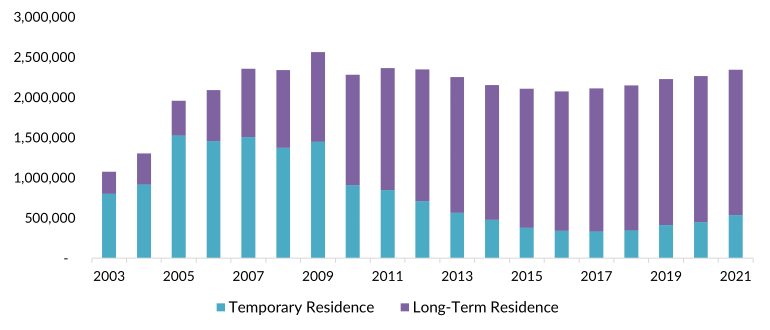
Source: Spanish Secretary of State for Migrations, “Estadísticas,” accessed March 17, 2023, available online.
To understand the labor market context, consider the unemployment rates of Spanish nationals and foreigners (see Figure 5). In 2007, amid the economic boom, immigrants’ employment rate exceeded that of Spanish nationals by nearly 10 percent. However, as the crisis struck, the situation of foreign workers deteriorated faster and more profoundly, due primarily to many holding more precarious contracts. The unemployment rate of Spanish nationals reached an eye-watering 24 percent in 2013, but this still compared favorably to the 37 percent of immigrants who were out of work. As the economy recovered, immigrants’ situation improved more rapidly—until the COVID-19-induced slump again illustrated the precariousness of many of their jobs.
Figure 5. Employment and Unemployment Rates in Spain, by Nationality, 2006-22
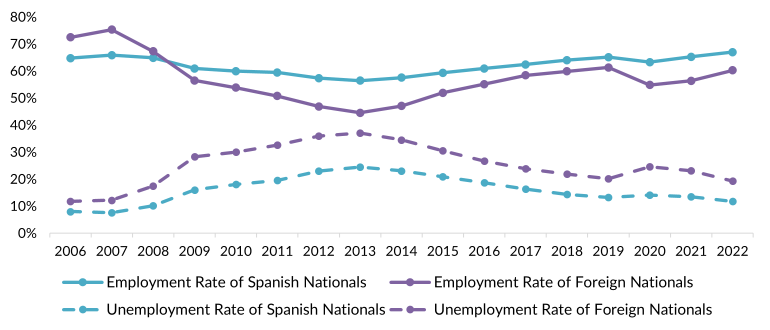
Notes: Numbers do not add up to 100 because the employment rate represents the share of the overall working-age population with a job, whereas the unemployment rate represents the share only of those who are economically active but lack a job and excludes people not looking for work. Data for Spanish nationals include those with multiple nationalities.
Source: INE, “Economically Active Population Survey. Results,” updated January 26, 2023, available online.
Within Spain’s notoriously segmented labor market, where unemployment is among the highest across the Organization for Economic Cooperation and Development (OECD), immigrants are over-represented in low-paying sectors with tough work conditions such as agriculture, catering, and domestic service. Consequently, immigrants’ standard of living tends to lag behind that of natives. Latin Americans frequently achieve better labor market outcomes than other immigrant groups due to factors such as Spanish language fluency, cultural affinities, and being viewed more favorably by natives.
Reflecting the crucial role of employment as a channel of immigrant inclusion, the vast majority of temporary residence permits used to be work-related. However, their share among valid authorizations has halved since 2009, whereas other categories, especially residence for humanitarian reasons, have increased sharply (see Figure 6). This is due primarily to the previously mentioned policy granting residence to rejected asylum applicants from Venezuela. Arraigo permits accounted for between 5 percent and 13 percent of all temporary authorizations held between 2009 and 2021. The consistency of this trend underscores how this tool has been critical for managing immigrants with irregular status. Over this time, the individualized arraigo process resulted in 650,000 regularizations of status.
Figure 6. Third-Country Nationals in Spain Holding Temporary Residence Permits, by Pathway, 2009-21
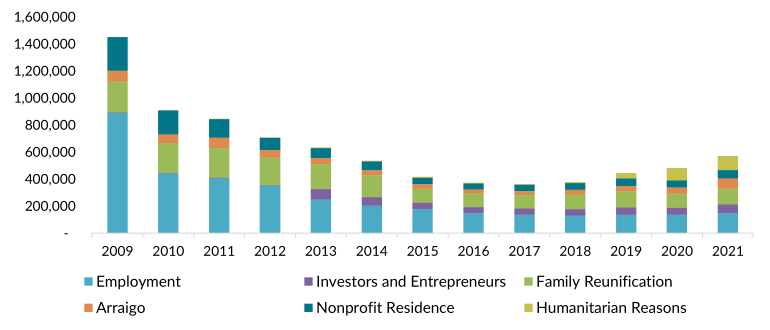
Notes: Investors and Entrepreneurs refers to beneficiaries of Law 14/2013 and others offering temporary legal status to individuals seeking to start businesses in Spain. Nonprofit Residence is a status available to third-country nationals who do not intend to engage in work activities and is largely used by people who can demonstrate they have the financial means to support themselves; many beneficiaries are from Morocco, Russia, or Venezuela.
Source: Spanish Secretary of State for Migrations, “Estadísticas.”
Citizenship
Eventually, the process of legal integration culminates with acquiring citizenship. In earlier years, only a fraction of Spain’s third-country residents qualified for naturalization (EU nationals tend not to bother), but this too has changed substantially. People from countries once part of Spain’s colonial empire require only two years of legal residence, whereas immigrants from other countries require ten years. This explains why more than two-thirds of the 1.6 million immigrants who attained Spanish citizenship from 2000 through 2019 are of Latin American origin (see Figure 7). Latin Americans’ share of all naturalized immigrants was especially high until recently, when other groups (especially Moroccans) have started to catch up. In 2013, an atypically high number of immigrants (261,000) became Spanish citizens due to an effort to clear a backlog of hundreds of thousands of unprocessed applications.
Figure 7. New Naturalizations in Spain by Region of Prior Nationality, 2000-19
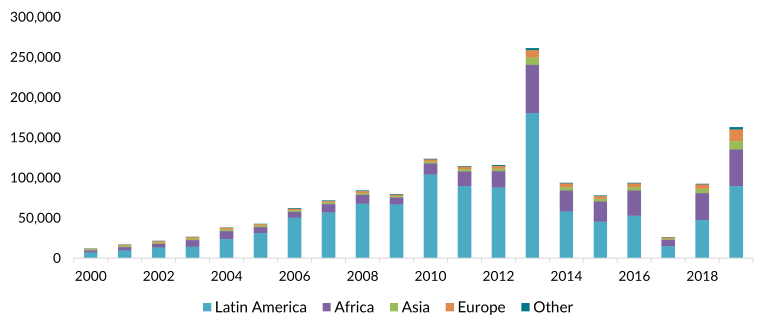
Source: Spanish Secretary of State for Migrations, “Estadísticas.”
During the most severe economic crisis in many Spaniards’ living memory, immigrants tended to secure more regular and stable status and acquire citizenship at higher numbers. This was especially true for those from Latin America, who have a preferential path to naturalization. When employment rates slumped, throttling work as an engine of integration, grants of legal status picked up the slack. Rather than amplifying those headwinds, improved access to civic and social rights—including citizenship in many cases—acted as stabilizing force. This is a sharp contrast with the first two decades of Spain’s emerging condition as prominent country of immigration, when regular status was difficult to achieve even amidst a booming labor market.
Public Attitudes: How Solid Is Spain’s Exceptionalism?
Cautious not to provoke nativist backlash, the Spanish government has done little to publicize its achievements incorporating immigrants, which continued even during the economic crisis. Since 2005, when the last large-scale regularization effort drew criticism from within Spain and abroad, the government has sought to avoid attracting attention to its immigration management. Crises made that occasionally impossible, such as during surging arrivals at the Canaries or massive border fence transgressions at Spain’s African exclaves, but even then, the government strived to scrub the issue from the headlines as quickly as possible. Since 2000, there has been no broad public debate of immigration legislation, and pathbreaking initiatives such as the 2013 naturalization drive were implemented with little fanfare. This approach helped blunt immigration as a political wedge issue for several years; unlike in many other Western countries, the topic is only rarely listed by Spaniards as a main problem facing the country.
However, this silence risked creating a vacuum to be filled by nativist rhetoric, which came to fruition in 2018 when VOX erupted into Spain’s political system as the first radical-right party since the Franco regime’s demise. VOX’s initial success was due primarily to backlash against Catalan separatism, yet the party’s fiercely nationalist platform includes aggressive rhetoric especially toward Muslim immigrants. In 2019 the party won the third most seats in the national parliament, and in 2022 it struck a deal with the conservative Popular Party (Partido Popular) to enter regional government for the first time, in the northwestern Castilla y León.
Throughout the past two decades, Spaniards’ attitudes toward immigration have been predominantly welcoming, especially in comparison to growing hostility in many other countries. Spain’s economic downturn did not trigger increased animosity towards the foreign-born. Rather, the hardship experienced by large swaths of society was blamed on politicians in Madrid as well as those in Berlin and Brussels.
Public-opinion data suggest that VOX did not fundamentally alter this state of affairs. Actually, the share of Spaniards saying immigration made their country a worse place to live has shrunk in recent years, and opinion polling shows less animosity toward immigrants in Spain than in countries with more resilient labor markets and stronger welfare states, such as Germany and Sweden, not to mention countries led by far-right leaders who have embraced nativist populism, such as Hungary and Italy (see Figure 8).
Figure 8. Share of Residents of Select Countries Saying Immigration Made Their Country a Worse Place to Live, 2014-22
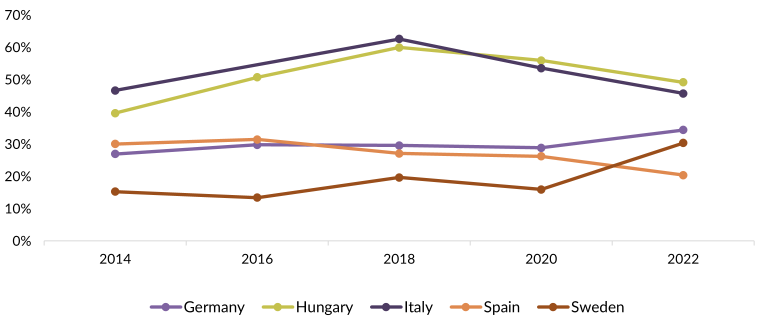
Note: Data are sums of 0-4 of an 11-point scale in which 0 is “worse” and 10 is “better.”
Source: Authors’ analysis based on data from European Social Survey (ESS), “ESS Data Portal,” accessed March 17, 2023, available online.
The determinants of these attitudes are hard to pin down. Crucial factors include the fact that many immigrants from Latin America speak Spanish and share cultural values, as well as the collective experience of the 1990s and early 2000s, when immigrant labor was needed to support the economic boom. So ingrained is the appreciation of immigrant labor that it is expressed even by people with otherwise unfavorable views of immigration.
However, it would be unwise to suggest these attitudes will necessarily continue indefinitely. Many Spaniards, especially the working poor, believe immigrants enjoy preferential access to health care and social benefits. Although such perceptions are often interwoven with prejudiced clichés, they should not be dismissed as unwarranted hostility, but may reflect shortcomings in public services and social benefit programs. Additionally, attitudes on immigration are susceptible to normative pressures in ways that can distort survey findings, especially amid the strong ideological polarization that Spain is undergoing. Hence, available public-opinion data are likely to underestimate the extent to which unease about immigration extends across the ideological spectrum. These observations imply potential openings for nativist rhetoric and increasing political salience of immigration-related issues in the years ahead.
Stepwise Stabilization
Since the turn of the century, Spain has developed and optimized an employment-based immigration model with procedures designed to grant successive stabilization of residence status. Immigrants’ legal status typically improves step by step: extensive civic and social rights by virtue of town-hall registration are complemented by temporary residence and work permits, which are converted later into permanent legal status, and eventually access to Spanish nationality. This process is not always smooth, nor does it guarantee rapid convergence with natives’ living standards.
However, the overall evolution of the Spanish migration regime throughout the past 25 years is remarkable. Rather than creating a self-perpetuating class of immigrants without legal status, irregularity has basically become a transitory stage that is part of an increasingly predictable path toward regularization. The individualized legalization process (arraigo) was crucial to achieving this outcome, since it allows the government to prevent large buildups of unauthorized immigrants without triggering media coverage and political backlash of the type that followed previous mass regularizations. Because it was enacted through the regulatory fine print of pre-existing legislation, the process circumvented public exposure and debate that might have heightened polarization.
The recent emergence of VOX raises the stakes for Spain’s low-profile approach to granting foreign-born residents essentially the same rights as natives. But the country’s evolution into a high-volume immigration country has been firmly cemented, even amid economic crisis and recent pandemic-related turbulence. And even if public attitudes were to shift markedly—a development that remains possible—the pillars of Spain’s migration regime might prove remarkably sturdy.
Sources
Arango, Joaquín. 2000. Becoming a Country of Immigration at the End of the Twentieth Century: The Case of Spain. In Eldorado or Fortress? Migration in Southern Europe, eds. Russell King, Gabriella Lazaridis, and Charalambos Tsardanidis. London: Palgrave Macmillan.
---. 2013. Exceptional in Europe? Spain’s Experience with Immigration and Integration. Washington, DC: Migration Policy Institute (MPI). Available online
Arango, Joaquín, ed. 2022. La inserción laboral y social de inmigrantes y refugiados en España. Almería, Spain: Cajamar.
Arango, Joaquín and Claudia Finotelli. 2009. Past and Future Challenges of a Southern European Migration Regime: The Spanish Case. IDEA working paper No. 8, N.p., May 2009. Available online.
Bruquetas-Callejo, María and Roberta Perna. 2020. Migration and Healthcare Reforms in Spain: Symbolic Politics, Converging Outputs, Oppositions from the Field. South European Society and Politics 25 (1): 75-98. Available online.
Carrera, Sergio. 2021. The Strasbourg Court Judgement 'N.D. and N.T. v Spain': A 'Carte Blanche' to Push Backs at EU External Borders? EUI RSCAS working paper 2020/21, Migration Policy Centre, Florence, Italy, 2020. Available online.
Cebolla-Boado, Héctor, María Miyar-Busto, and Jacobo Muñoz-Comet. 2015. Is the Spanish Recession Increasing Inequality? Male Migrant-Native Differences in Educational Returns Against Unemployment. Journal of Ethnic and Migration Studies 41(5): 710–28.
Domingo, Andreu, Albert Sabater, and Richard R. Verdugo, eds. 2015. Demographic Analysis of Latin American Immigrants in Spain: From Boom to Bust. New York: Springer.
Echeverría, Gabriel. 2020. Towards a Systemic Theory of Irregular Migration: Explaining Ecuadorian Irregular Migration in Amsterdam and Madrid. Cham, Switzerland: Springer. Available online.
European Court for Human Rights. 2020. N.D. and N.T. v. Spain [GC] - 8675/15 and 8697/15, Judgment 13.2.2020 [GC]. February, 2020. Available online.
European Social Survey (ESS). N.d. ESS Data Portal. Accessed March 17, 2023. Available online.
Eurostat. 2022. Migration and Migrant Population Statistics. Updated March 2022. Available online.
Ferrer-Gallardo, Xavier and Lorenzo Gabrielli. 2022. The Ceuta Border Peripeteia: Tasting the Externalities of EU Border Externalization. Journal of Borderlands Studies 37 (3): 645-55.
Finotelli, Claudia. 2018. Southern Europe: Twenty-Five Years of Immigration Control on the Waterfront. In The Routledge Handbook of Justice and Home Affairs Research, eds. Ariadna Ripoll Servent and Florian Trauner. London: Routledge.
Finotelli, Claudia and Joaquín Arango. 2011. Regularisation of Unauthorised Immigrants in Italy and Spain: Determinants and Effects. Documents d’Anàlisi Geogràfica 57 (3): 495-515. Available online.
Finotelli, Claudia and Maria Caterina La Barbera. 2013. When the Exception Becomes the Rule: The Spanish Citizenship Regime. Migration Letters 10 (2): 245-53. Available online.
Godenau, Dirk and Ana López-Sala. 2016. Multi-Layered Migration Deterrence and Technology in Spanish Maritime Border Management. Journal of Borderland Studies 31 (2): 151-69.
Godenau, Dirk, Sebastian Rinken, Antidio Martínez de Lizarrondo Artola, and Gorka Moreno Márquez. 2017. La integración de los inmigrantes en España: fases, patrones y dinámicas regionales durante el período 2007-2015. Madrid: Spanish Ministry of Employment and Social Security. Available online.
González Enríquez, Carmen and Sebastian Rinken. 2021. Spanish Public Opinion on Immigration and the Effect of VOX. Instituto Real Elcano, April 15, 2021. Available online.
Iglesias, Juan, Antonio Rua, and Alberto Ares. 2020. Un arraigo sobre el alambre. La integración social de la población de origen migrante en España. Madrid: Fundación Foessa y Caritas Española. Available online.
Mahía, Ramón. 2018. Población extranjera residente en España: evolución, características e integración económica. In Inmigración y asilo, en el centro de la arena política. Anuario CIDOB de la Inmigración 2018, eds. Joaquín Arango, Ramón Mahía, David Moya, and Elena Sánchez-Montijano. Barcelona: CIDOB. Available online.
Martín-Pérez, Alberto and Francisco Javier Moreno-Fuentes. 2012. Migration and Citizenship Law in Spain: Path-Dependency and Policy Change in a Recent Country of Immigration. International Migration Review 46 (3): 625-55.
Migration Policy Index (MIPEX). N.d. Spain. Accessed March 17, 2023. Available online.
Spanish Interior Ministry. 2019. Nota sobre la propuesta de concesión de una autorización temporal de residencia por razones humanitarias. Madrid: Spanish Interior Ministry. Available online.
Organization for Economic Cooperation and Development (OECD). N.d. Spain. Accessed March 17, 2023. Available online.
Ortega Pérez, Nieves. 2003. Spain: Forging an Immigration Policy. Migration Information Source, February 1, 2003. Available online.
Parella, Sònia and Alisa Petroff. 2014. Migración de retorno en España: salidas de inmigrantes y programas de retorno en un contexto de crisis. In Inmigración y Emigración: mitos y realidades. Anuario de la Inmigración en España 2013 (edición 2014), eds. Joaquín Arango, David Moya Malapeira, and Josep Oliver Alonso. Barcelona: CIDOB. Available online.
Portes, Alejando, Rosa Aparicio, and William Haller. 2018. Hacerse adulto en España: La integración de los hijos de inmigrantes. In Inmigración y asilo, en el centro de la arena política. Anuario CIDOB de la Inmigración 2018, eds. Joaquín Arango, Ramón Mahía, David Moya, and Elena Sánchez-Montijano. Barcelona: CIDOB. Available online.
Prieto-Rosas, Victoria, Joaquín Recaño, and Doris Cristina Quintero-Lesmes. 2018. Migration Responses of Immigrants in Spain during the Great Recession. Demographic Research 38 (61): 1885-932. Available online.
Rinken, Sebastian. 2016. Economic Crisis and Anti-Immigrant Sentiment: The Case of Andalusia. Revista Española de Investigaciones Sociológicas 156: 77-96. Available online.
Rinken, Sebastian, Dirk Godenau, and Antidio Martínez de Lizarrondo Artola. 2018. La integración de los inmigrantes en España: ¿pautas diferenciadas en distintas etapas de la crisis? In Inmigración y asilo, en el centro de la arena política. Anuario CIDOB de la Inmigración 2018, eds. Joaquín Arango, Ramón Mahía, David Moya, and Elena Sánchez-Montijano. Barcelona: CIDOB. Available online.


